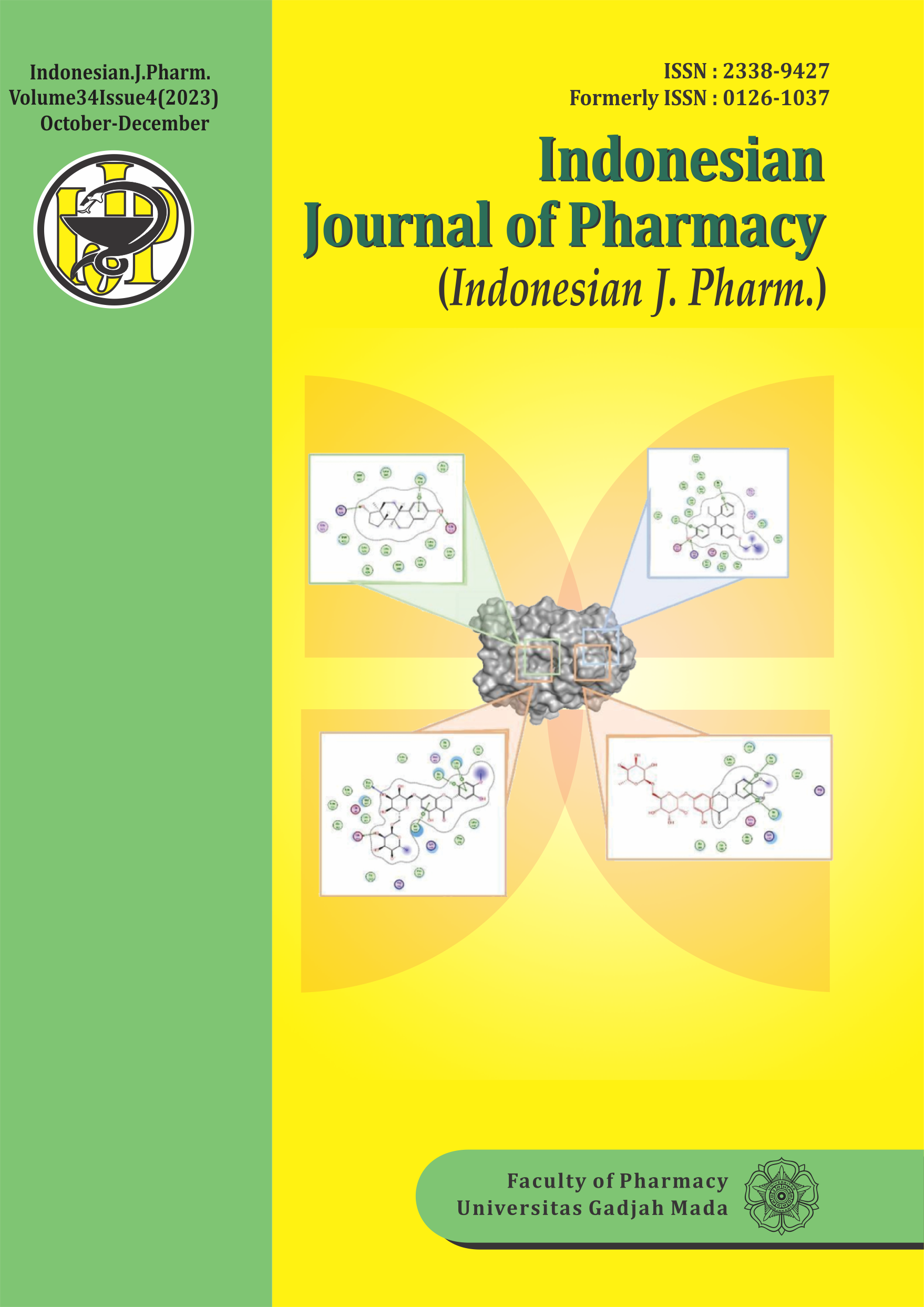Effectiveness of Dry Grinding and Wet Grinding Methods on Physicochemical Properties, Solubility, and Dissolution Rate of Nimodipine-HPMC Nanoparticles
Abstract
Nimodipine is a dihydropyridine calcium channel blocker that shares the general properties of nifedipine, but acts mainly on cerebral blood vessels. Nimodipine belongs to the Class II Biopharmaceutical Classification System (BCS) drug group, which has low solubility and high permeability. The purpose of this study was to look at the differences in the yield of nanoparticles between the dry grinding and wet grinding methods on the physicochemical properties, solubility, and dissolution rate of nimodipine nanoparticles. The nanoparticles were prepared a nimodipine: HPMC ratio of 1:0.6 using two different methods. Sample characterization was carried out using Particle Size Analyzer (PSA), Scanning Electron Microscopy (SEM), Differential Scanning Calorimetry (DSC), X-ray Diffraction (XRD), and Fourier Transform Infrared (FT-IR). The Solubility test was carried out in CO2-free distilled water and the dissolution rate was carried out in phosphate buffer pH 7.2. The solubility of pure nimodipine in CO2-free distilled water was 0.339 µg/mL, the physical mixture was 1.948 µg/mL, the dry grinding nanoparticles were 3.367 µg/mL, and the wet grinding nanoparticles were 19.952 µg/mL. The dissolution test results obtained with the percentage of pure nimodipine dissolution at 60th minutes was 33.947%, the physical mixture was 39.482%, the dry grinding nanoparticles were 49.798%, and the wet grinding nanoparticles were 56.484%. Based on the results of the study, it can be said that the nimodipine-HPMC nanoparticles significantly increased the solubility and dissolution rate of nimodipine.
References
Alhagiesa, A.W., & Ghareeb, M.M. (2021). Formulation and Characterization of Nimodipine Nanoparticles for the Enhancement of solubility and dissolution rate. Iraqi J Pharm Sci, 30(2), 143-152.
Bunaciu, A.A., Udristioiu, E.G, & Aboul-Enein, H.Y. (2015). X-Ray Diffraction: Instrumentation and Applications. Critical Reviews in Analytical Chemistry, 45, 289–299.
Fu, Q., Sun, J., Zhang, D., Li, M., Wang, Y., Ling, G., Liu, X., Sun, Y., & Sui, X. (2013). Nimodipine nanocrystals for oral bioavailability improvement (part I): preparation, characterization and pharmacokinetic studies. Colloids and Surfaces B: Biointerfaces. 109, 161-166.
George, A., Shah, P.A., & Shrivastav, P.S. (2019). Natural biodegradable polymers based nano-formulations for drug delivery: A review. International journal of pharmaceutics, 561, 244-264.
Ghareeb, M.M., & Neamah, A.J. (2017). Formulation and Characterization of Nimodipine Nanoemulsion as Ampoule for Oral Route. International Journal of Pharmaceutical Sciences and Research, 8(2), 591-602.
Gohil, T. (2014). Solubility Enhancement of Poorly Water Soluble Drug Aceclofenac. Indonesia J Pharm, 25(1), 1-8.
Hui, Z,L., Kumar, A, S., & Wan, P.S.H. (2014). Overview of milling techniques for improving the solubility of poorly water-soluble drugs. Asean Journal of Pharmaceutical Sciences, 10(4), 255-274.
Li, J., Fu, Q., Liu, X., Li, M., & Wang, Y. (2015). Formulation of nimodipine nanocrystals for oral administration. Arch. Pharm. Res.
Maheshwara, R.J., Shyam, S.R., & Krishna, S.A. (2014). Formulation Characterization and Optimization of Process Variables Chitosan Nanoparticles Containing Sulfasalazine. Journal of Chemical and Pharmaceutical Sciences, 7(2), 67-72.
Mohanraj, V.J., & Chen, Y. (2006). Nanoparticles - A review. Tropical Journal of Pharmaceutical Research, 5(1), 561-573.
Moschwitzer, J.P. (2013). Drug nanocrystals in the commercial pharmaceutical development process. International Journal of Pharmaceutics, 453(1), 142-156.
Mudshinge, S.R., Deore A.B., Patil S., & Bhalgat, C.M. (2011). Nanoparticles: Emerging carriers for drug delivery. Saudi Pharmaceutical Journal, 19, 129–141.
Novita, G., Nurono, S.S., Sasongko, L.D.N., & Ismunandar. (2014). Pengaruh Penggilingan Terhadap Padatan Nimodipin. Jurnal Sains Materi Indonesia, 15(3), 166-170.
Ohenoja, K., Saari, J., Illikainen M., Breitung-Faes, S., Kwade, A., & Niinimäki, J. (2014). Effect of Polydispersity Index on the Grinding Limits of Highly Concentrated Limestone Suspensions. Chem. Eng. Technol, 37(5), 833–839.
Papadimitriou, S., Papageorgiou, G.Z, Kanaze, F.I., Georgarakis, M., & Bikiaris, D.N. (2009). Nanoencapsulation of Nimodipine in Novel Biocompatible Poly(propylene-co-butylene succinate) Aliphatic Copolyesters for Sustained Release. Journal of Nanomaterials, 1-11.
Sweetman, S.C. (2009). Martindale: The Complete Drug Reference (36th ed.). London: The Pharmaceutical Press.
Tawakoli, T., Westkaemper, E., & Rabiey, M. (2007). Dry grinding by special conditioning. Int J Adv Manuf Technol, 33(3), 419–424.
Teng, Z., Yu, M., Ding, Y., Zhang, H., Shen, Y., Jiang, M., Liu, P., Opoku-Damoah, Y., Webster, T.J., & Zhou, J. (2019). Preparation and characterization of nimodipineloaded nanostructured lipid systems for enhanced solubility and bioavailability. International Journal of Nanomedicine, 14, 119–133.
Tozuka, Y., Imono, M., Uchiyama, H., & Takeuchi, H. (2011). A novel application of a-glucosyl hesperidin for nanoparticle formation of active pharmaceutical ingredients by dry grinding. European Journal of Pharmaceutics and Biopharmaceutics, 79(3), 559-565.
Windriyati, Y.N., Badriyah, M., Kusumaningtyas, D.A., & Riesmalia, R.L. (2020). Liquisolid Tablets Formulation of Atorvastatin Calcium Using Polyethylene Glycol 400 as Solvent and Some Carrier Materials. Indonesian Journal of Pharmacy, 3(4), 305–311.
Zhao, Y., Xin, T., Ye, T., Yang, X., & Pan, W. (2014). Solid dispersion in the development of a nimodipine delayed-release tablet formulation. Asian Journal of Pharmaceutical Sciences, 9(1), 35-41.
Williams, H.D., Trevaskis, N.L., Charman, S.A., Shanker, R.M., Charman, W.N., Pouton, C.W., & Porter, C.J.H. (2013). Strategies to Address Low Drug Solubility in Discovery and Development. Pharmacological Reviews, 65(1), 315–499.








